Stewart J. Calculus
Подождите немного. Документ загружается.

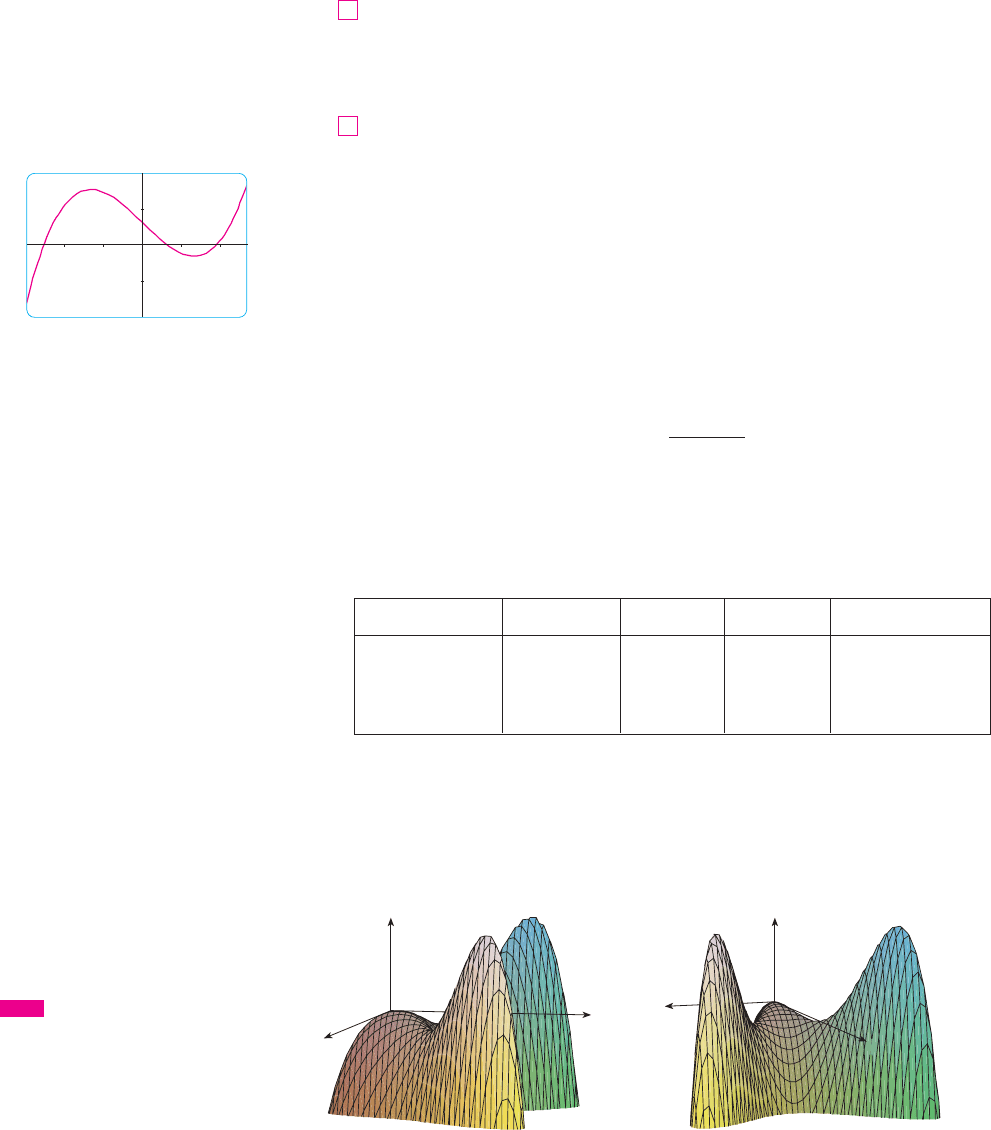
In the second case , we get
and, putting this in Equation 5, we have . So we have to
solve the cubic equation
Using a graphing calculator or computer to graph the function
as in Figure 6, we see that Equation 7 has three real roots. By zooming in, we can find
the roots to four decimal places:
(Alternatively, we could have used Newton’s method or a rootfinder to locate these
roots.) From Equation 6, the corresponding -values are given by
If , then x has no corresponding real values. If , then
. If , then . So we have a total of five critical
points, which are analyzed in the following chart. All quantities are rounded to two
decimal places.
Figures 7 and 8 give two views of the graph of and we see that the surface opens
downward. [This can also be seen from the expression for : The dominant terms
are when and are large.] Comparing the values of at its local maxi-
mum points, we see that the absolute maximum value of is . In
other words, the highest points on the graph of are .
M
FIGURE 7 FIGURE 8
y
x
z
y
z
x
共⫾2.64, 1.90, 8.50兲f
f 共⫾2.64, 1.90兲⬇8.50f
f
ⱍ
y
ⱍⱍ
x
ⱍ
⫺x
4
⫺ 2y
4
f 共x, y兲
f
x ⬇ ⫾2.6442y ⬇ 1.8984x ⬇ ⫾0.8567
y ⬇ 0.6468y ⬇ ⫺2.5452
x 苷 ⫾
s
5y ⫺ 2.5
x
y ⬇ 1.8984 y ⬇ 0.6468 y ⬇ ⫺2.5452
t共y兲 苷 4y
3
⫺ 21y ⫹ 12.5
4y
3
⫺ 21y ⫹ 12.5 苷 0
7
25y ⫺ 12.5 ⫺ 4y ⫺ 4y
3
苷 0
x
2
苷 5y ⫺ 2.5
6
共10y ⫺ 5 ⫺ 2x
2
苷 0兲
962
||||
CHAPTER 15 PARTIAL DERIVATIVES
Critical point Value of D Conclusion
0.00 ⫺10.00 80.00 local maximum
8.50 ⫺55.93 2488.72 local maximum
⫺1.48 ⫺5.87 ⫺187.64 saddle point共⫾0.86, 0.65兲
共⫾2.64, 1.90兲
共0, 0兲
f
xx
f
FIGURE 6
_3 2.7
Visual 15.7 shows several families
of surfaces.The surface in Figures 7 and 8
is a member of one of these families.
TEC
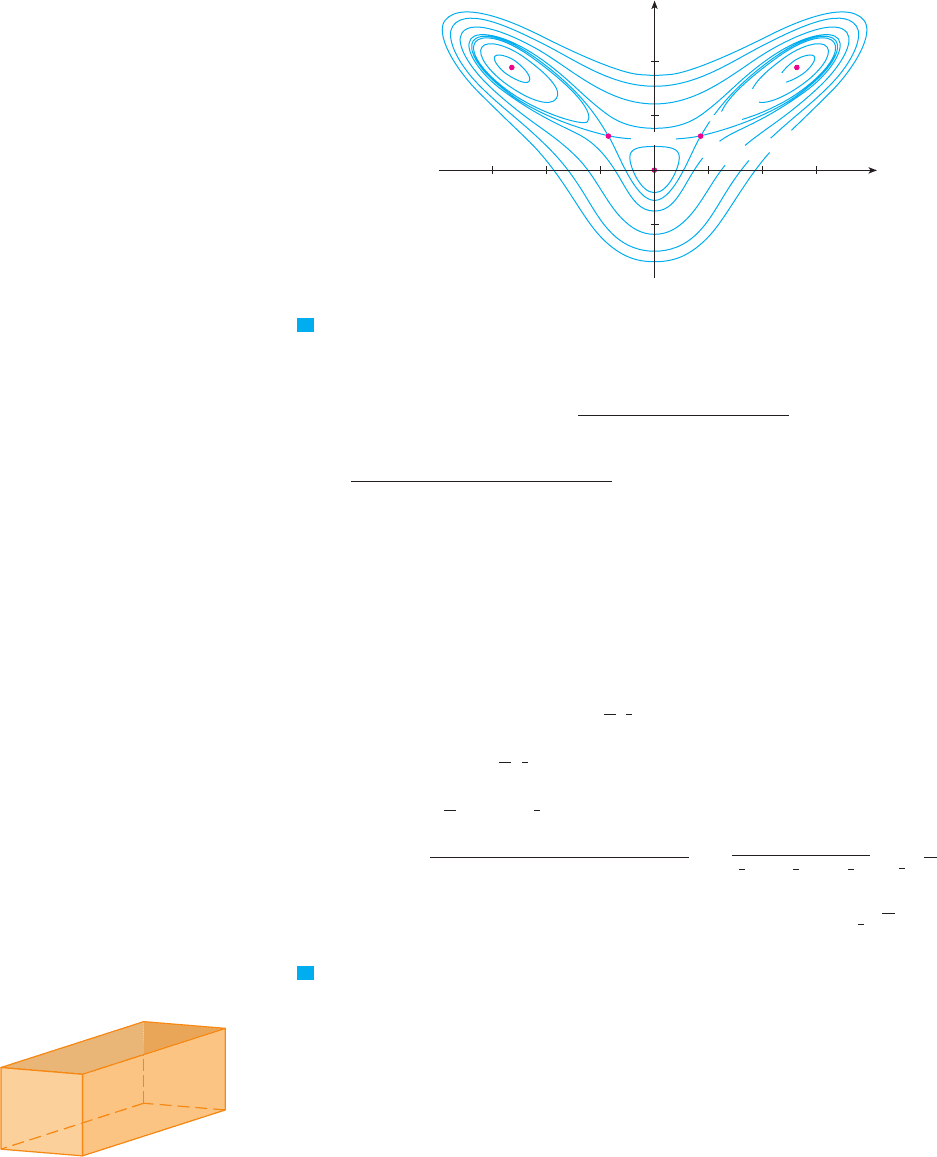
EXAMPLE 5 Find the shortest distance from the point to the plane
.
SOLUTION The distance from any point to the point is
but if lies on the plane , then and so we have
. We can minimize by minimizing the simpler
expression
By solving the equations
we find that the only critical point is . Since , , and , we
have and , so by the Second Derivatives Test
has a local minimum at . Intuitively, we can see that this local minimum is actually
an absolute minimum because there must be a point on the given plane that is closest to
. If and , then
The shortest distance from to the plane is . M
EXAMPLE 6 A rectangular box without a lid is to be made from 12 m of cardboard.
Find the maximum volume of such a box.
SOLUTION Let the length, width, and height of the box (in meters) be , , and , as shown
in Figure 10. Then the volume of the box is
We can express as a function of just two variables and by using the fact that the
area of the four sides and the bottom of the box is
2xz ⫹ 2yz ⫹ xy 苷 12
yxV
V 苷 xyz
zyx
2
V
5
6
s
6
x ⫹ 2y ⫹ z 苷 4共1, 0, ⫺2兲
d 苷
s
共x ⫺ 1兲
2
⫹ y
2
⫹ 共6 ⫺ x ⫺ 2y兲
2
苷
s
(
5
6
)
2
⫹
(
5
3
)
2
⫹
(
5
6
)
2
苷
5
6
s
6
y 苷
5
3
x 苷
11
6
共1, 0, ⫺2兲
(
11
6
,
5
3
)
ff
xx
⬎ 0D共x, y兲 苷 f
xx
f
yy
⫺ 共 f
xy
兲
2
苷 24 ⬎ 0
f
yy
苷 10f
xy
苷 4f
xx
苷 4
(
11
6
,
5
3
)
f
y
苷 2y ⫺ 4共6 ⫺ x ⫺ 2y兲 苷 4x ⫹ 10y ⫺ 24 苷 0
f
x
苷 2共x ⫺ 1兲 ⫺ 2共6 ⫺ x ⫺ 2y兲 苷 4x ⫹ 4y ⫺ 14 苷 0
d
2
苷 f 共x, y兲 苷 共x ⫺ 1兲
2
⫹ y
2
⫹ 共6 ⫺ x ⫺ 2y兲
2
dd 苷
s
共x ⫺ 1兲
2
⫹ y
2
⫹ 共6 ⫺ x ⫺ 2y兲
2
z 苷 4 ⫺ x ⫺ 2yx ⫹ 2y ⫹ z 苷 4共x, y, z兲
d 苷
s
共x ⫺ 1兲
2
⫹ y
2
⫹ 共z ⫹ 2兲
2
共1, 0, ⫺2兲共x, y, z兲
x ⫹ 2y ⫹ z 苷 4
共1, 0, ⫺2兲
V
FIGURE 9
3
x
1
_1
2
y
_
3
_10
_20
_30
3
7
_1.48
_0.8
_3
SECTION 15.7 MAXIMUM AND MINIMUM VALUES
||||
963
N The five critical points of the function in
Example 4 are shown in red in the contour map
of in Figure 9.f
f
N Example 5 could also be solved using
vectors. Compare with the methods of
Section 13.5.
FIGURE 10
y
x
z
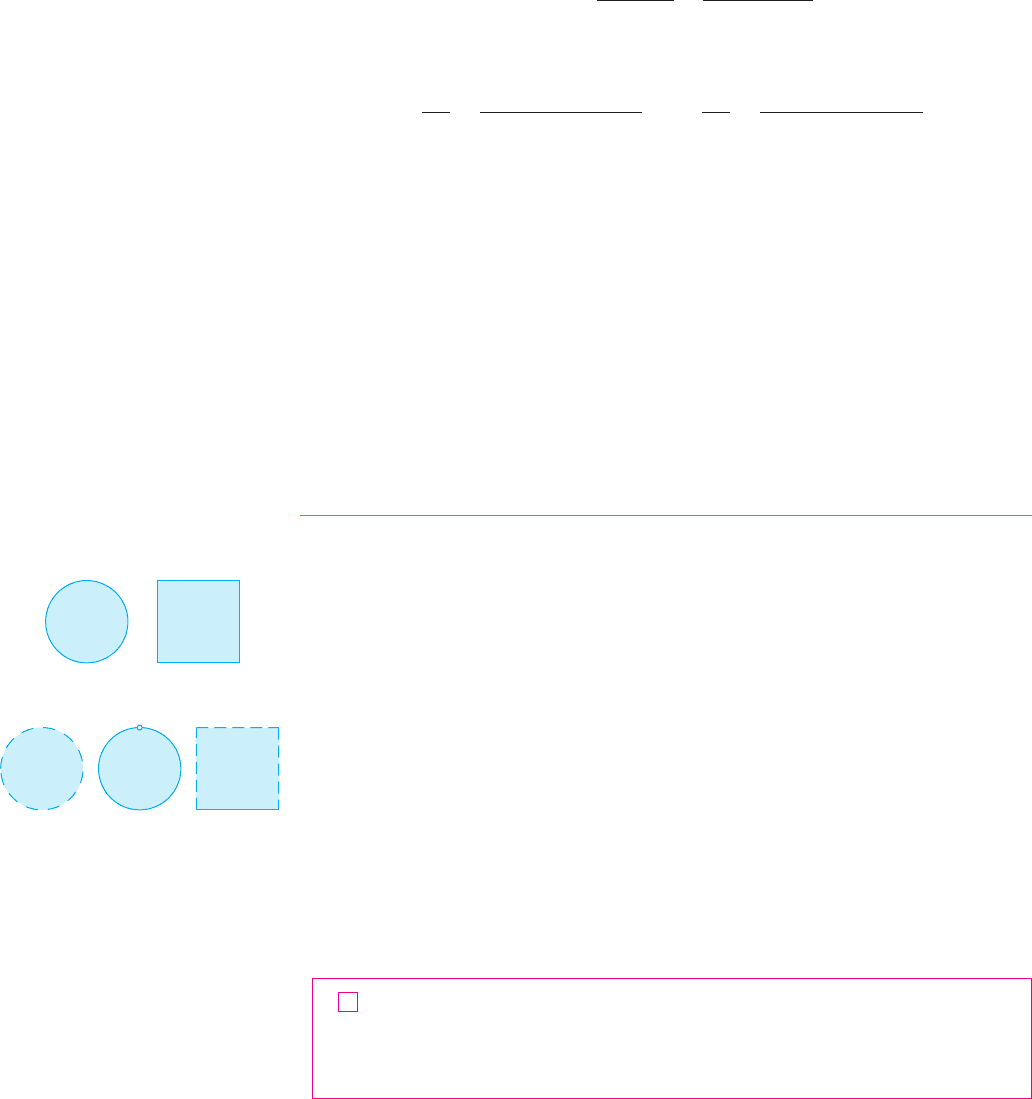
Solving this equation for , we get , so the expression for
becomes
We compute the partial derivatives:
If is a maximum, then , but or gives , so we
must solve the equations
These imply that and so . (Note that and must both be positive in this
problem.) If we put in either equation we get , which gives ,
, and .
We could use the Second Derivatives Test to show that this gives a local maximum
of , or we could simply argue from the physical nature of this problem that there must
be an absolute maximum volume, which has to occur at a critical point of , so it must
occur when , , . Then , so the maximum volume of
the box is 4 m . M
ABSOLUTE MAXIMUM AND MINIMUM VALUES
For a function of one variable the Extreme Value Theorem says that if is continuous
on a closed interval , then has an absolute minimum value and an absolute maxi-
mum value. According to the Closed Interval Method in Section 4.1, we found these by
evaluating not only at the critical numbers but also at the endpoints and .
There is a similar situation for functions of two variables. Just as a closed interval con-
tains its endpoints, a closed set in is one that contains all its boundary points. [A bound-
ary point of D is a point such that every disk with center contains points in D
and also points not in D.] For instance, the disk
which consists of all points on and inside the circle , is a closed set because it
contains all of its boundary points (which are the points on the circle ). But if
even one point on the boundary curve were omitted, the set would not be closed. (See
Figure 11.)
A bounded set in is one that is contained within some disk. In other words, it is
finite in extent. Then, in terms of closed and bounded sets, we can state the following coun-
terpart of the Extreme Value Theorem in two dimensions.
EXTREME VALUE THEOREM FOR FUNCTIONS OF TWO VARIABLES If is continu-
ous on a closed, bounded set in , then attains an absolute maximum value
and an absolute minimum value at some points and
in .D共x
2
, y
2
兲
共x
1
, y
1
兲f 共x
2
, y
2
兲f 共x
1
, y
1
兲
f⺢
2
D
f
8
⺢
2
x
2
⫹ y
2
苷 1
x
2
⫹ y
2
苷 1
D 苷 兵共x, y兲
ⱍ
x
2
⫹ y
2
艋 1其
共a, b兲共a, b兲
⺢
2
baf
f关a, b兴
ff
3
V 苷 2 ⴢ 2 ⴢ 1 苷 4z 苷 1y 苷 2x 苷 2
V
V
z 苷 共12 ⫺ 2 ⴢ 2兲兾关2共2 ⫹ 2兲兴 苷 1y 苷 2
x 苷 212 ⫺ 3x
2
苷 0x 苷 y
yxx 苷 yx
2
苷 y
2
12 ⫺ 2xy ⫺ y
2
苷 012 ⫺ 2xy ⫺ x
2
苷 0
V 苷 0y 苷 0x 苷 0⭸V兾⭸x 苷 ⭸V兾⭸y 苷 0V
⭸V
⭸y
苷
x
2
共12 ⫺ 2xy ⫺ y
2
兲
2共x ⫹ y兲
2
⭸V
⭸x
苷
y
2
共12 ⫺ 2xy ⫺ x
2
兲
2共x ⫹ y兲
2
V 苷 xy
12 ⫺ xy
2共x ⫹ y兲
苷
12xy ⫺ x
2
y
2
2共x ⫹ y兲
Vz 苷 共12 ⫺ xy兲兾关2共x ⫹ y兲兴z
964
||||
CHAPTER 15 PARTIAL DERIVATIVES
(a) Closed sets
(b) Sets that are not closed
FIGURE 11

To find the extreme values guaranteed by Theorem 8, we note that, by Theorem 2, if
has an extreme value at , then is either a critical point of or a boundary
point of . Thus we have the following extension of the Closed Interval Method.
To find the absolute maximum and minimum values of a continuous function
on a closed, bounded set :
1. Find the values of at the critical points of in .
2. Find the extreme values of on the boundary of .
3. The largest of the values from steps 1 and 2 is the absolute maximum value;
the smallest of these values is the absolute minimum value.
EXAMPLE 7 Find the absolute maximum and minimum values of the function
on the rectangle .
SOLUTION Since is a polynomial, it is continuous on the closed, bounded rectangle ,
so Theorem 8 tells us there is both an absolute maximum and an absolute minimum.
According to step 1 in (9), we first find the critical points. These occur when
so the only critical point is , and the value of there is .
In step 2 we look at the values of on the boundary of , which consists of the four
line segments , , , shown in Figure 12. On we have and
This is an increasing function of , so its minimum value is and its maxi-
mum value is . On we have and
This is a decreasing function of , so its maximum value is and its minimum
value is . On we have and
By the methods of Chapter 4, or simply by observing that , we see
that the minimum value of this function is and the maximum value is
. Finally, on we have and
with maximum value and minimum value . Thus, on the bound-
ary, the minimum value of is 0 and the maximum is 9.
In step 3 we compare these values with the value at the critical point and
conclude that the absolute maximum value of on is and the absolute
minimum value is . Figure 13 shows the graph of . M
ff 共0, 0兲 苷 f 共2, 2兲 苷 0
f 共3, 0兲 苷 9Df
f 共1, 1兲 苷 1
f
f 共0, 0兲 苷 0f 共0, 2兲 苷 4
0 艋 y 艋 2f 共0, y兲 苷 2y
x 苷 0L
4
f 共0, 2兲 苷 4
f 共2, 2兲 苷 0
f 共x, 2兲 苷 共x ⫺ 2兲
2
0 艋 x 艋 3f 共x, 2兲 苷 x
2
⫺ 4x ⫹ 4
y 苷 2L
3
f 共3, 2兲 苷 1
f 共3, 0兲 苷 9y
0 艋 y 艋 2f 共3, y兲 苷 9 ⫺ 4y
x 苷 3L
2
f 共3, 0兲 苷 9
f 共0, 0兲 苷 0x
0 艋 x 艋 3f 共x, 0兲 苷 x
2
y 苷 0L
1
L
4
L
3
L
2
L
1
Df
f 共1, 1兲 苷 1f共1, 1兲
f
y
苷 ⫺2x ⫹ 2 苷 0f
x
苷 2x ⫺ 2y 苷 0
Df
D 苷 兵共x, y兲
ⱍ
0 艋 x 艋 3, 0 艋 y 艋 2其f 共x, y兲 苷 x
2
⫺ 2xy ⫹ 2y
Df
Dff
Df
9
D
f共x
1
, y
1
兲共x
1
, y
1
兲
f
SECTION 15.7 MAXIMUM AND MINIMUM VALUES
||||
965
y
x
(0,0)
(0,2)
(2,2)
(3,2)
(3,0)
L¡
L¢ L™
L£
FIGURE 12
9
0
0
2
3
L¡
L™
D
FIGURE 13
f(x,y)=≈-2xy+2y
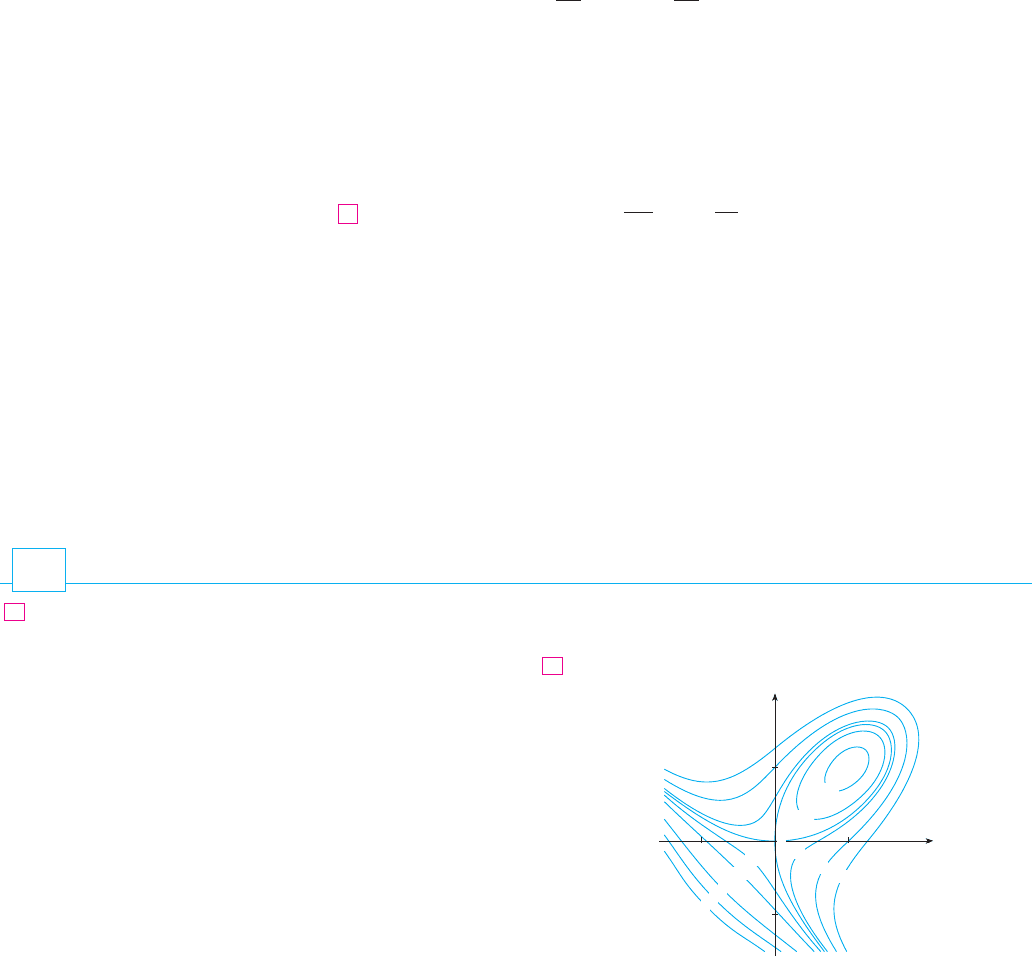
We close this section by giving a proof of the first part of the Second Derivatives Test.
Part (b) has a similar proof.
PROOF OF THEOREM 3, PART (A) We compute the second-order directional derivative of in
the direction of . The first-order derivative is given by Theorem 15.6.3:
Applying this theorem a second time, we have
(by Clairaut’s Theorem)
If we complete the square in this expression, we obtain
We are given that and . But and are con-
tinuous functions, so there is a disk with center and radius such that
and whenever is in . Therefore, by looking at Equation
10, we see that whenever is in . This means that if is the curve
obtained by intersecting the graph of with the vertical plane through in
the direction of , then is concave upward on an interval of length . This is true in
the direction of every vector , so if we restrict to lie in , the graph of lies
above its horizontal tangent plane at . Thus whenever is in .
This shows that is a local minimum.
M
f 共a, b兲
B共x, y兲f 共x, y兲 艌 f 共a, b兲P
fB共x, y兲u
2
␦
Cu
P共a, b, f 共a, b兲兲f
CB共x, y兲D
u
2
f 共x, y兲 ⬎ 0
B共x, y兲D共x, y兲 ⬎ 0f
xx
共x, y兲 ⬎ 0
␦
⬎ 0共a, b兲B
D 苷 f
xx
f
yy
⫺ f
xy
2
f
xx
D共a, b兲 ⬎ 0f
xx
共a, b兲 ⬎ 0
D
2
u
f 苷 f
xx
冉
h ⫹
f
xy
f
xx
k
冊
2
⫹
k
2
f
xx
共 f
xx
f
yy
⫺ f
2
xy
兲
10
苷 f
xx
h
2
⫹ 2 f
xy
hk ⫹ f
yy
k
2
苷 共 f
xx
h ⫹ f
yx
k兲h ⫹ 共 f
xy
h ⫹ f
yy
k兲k
D
2
u
f 苷 D
u
共D
u
f 兲 苷
⭸
⭸x
共D
u
f 兲h ⫹
⭸
⭸y
共D
u
f 兲k
D
u
f 苷 f
x
h ⫹ f
y
k
u 苷 具h, k 典
f
966
||||
CHAPTER 15 PARTIAL DERIVATIVES
reasoning. Then use the Second Derivatives Test to confirm your
predictions.
x
y
4
4.2
5
6
1
1
3.7
3.7
3.2
3.2
2
1
0
_1
_1
f 共x, y兲 苷 4 ⫹ x
3
⫹ y
3
⫺ 3xy
3.
Suppose is a critical point of a function with contin-
uous second derivatives. In each case, what can you say
about ?
(a)
(b)
2. Suppose (0, 2) is a critical point of a function t with contin-
uous second derivatives. In each case, what can you say
about t?
(a)
(b)
(c)
3–4 Use the level curves in the figure to predict the location of
the critical points of and whether has a saddle point or a
local maximum or minimum at each critical point. Explain your
ff
t
yy
共0, 2兲 苷 9t
xy
共0, 2兲 苷 6, t
xx
共0, 2兲 苷 4,
t
yy
共0, 2兲 苷 ⫺8t
xy
共0, 2兲 苷 2, t
xx
共0, 2兲 苷 ⫺1,
t
yy
共0, 2兲 苷 1t
xy
共0, 2兲 苷 6, t
xx
共0, 2兲 苷 ⫺1,
f
yy
共1, 1兲 苷 2f
xy
共1, 1兲 苷 3, f
xx
共1, 1兲 苷 4,
f
yy
共1, 1兲 苷 2f
xy
共1, 1兲 苷 1, f
xx
共1, 1兲 苷 4,
f
f共1, 1兲
1.
EXERCISES
15.7
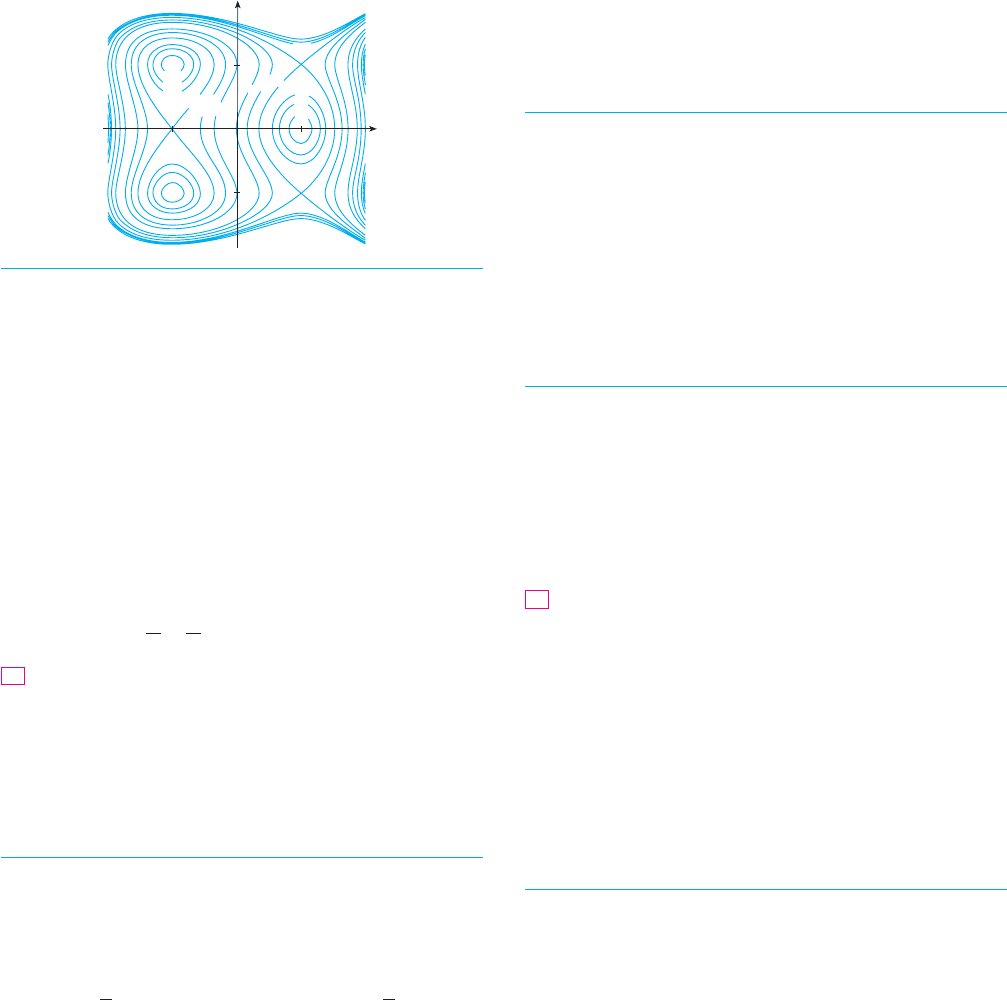
SECTION 15.7 MAXIMUM AND MINIMUM VALUES
||||
967
22.
23.
,
,
24. ,
,
;
25–28 Use a graphing device as in Example 4 (or Newton’s
method or a rootfinder) to find the critical points of correct to
three decimal places. Then classify the critical points and find the
highest or lowest points on the graph.
25.
26.
27.
28.
29–36 Find the absolute maximum and minimum values of on
the set .
29. , is the closed triangular region
with vertices , , and
30. , is the closed triangular
region with vertices , , and
,
32. ,
33. ,
34. ,
35. ,
36. , is the quadrilateral
whose vertices are , , , and .
;
37. For functions of one variable it is impossible for a continuous
function to have two local maxima and no local minimum.
But for functions of two variables such functions exist. Show
that the function
has only two critical points, but has local maxima at both
of them. Then use a computer to produce a graph with a
carefully chosen domain and viewpoint to see how this is
possible.
;
38. If a function of one variable is continuous on an interval and
has only one critical number, then a local maximum has to be
f 共x, y兲 苷 ⫺共x
2
⫺ 1兲
2
⫺ 共x
2
y ⫺ x ⫺ 1兲
2
共⫺2, ⫺2兲共2, 2兲共2, 3兲共⫺2, 3兲
Df 共x, y兲 苷 x
3
⫺ 3x ⫺ y
3
⫹ 12y
D 苷 兵共x, y兲
ⱍ
x
2
⫹ y
2
艋 1其f 共x, y兲 苷 2x
3
⫹ y
4
D 苷 兵共x, y兲
ⱍ
x 艌 0, y 艌 0, x
2
⫹ y
2
艋 3其f 共x, y兲 苷 xy
2
D 苷 兵共x, y兲
ⱍ
0 艋 x 艋 3, 0 艋 y 艋 2其
f 共x, y兲 苷 x
4
⫹ y
4
⫺ 4xy ⫹ 2
D 苷 兵共x, y兲
ⱍ
0 艋 x 艋 4, 0 艋 y 艋 5其
f 共x, y兲 苷 4x ⫹ 6y ⫺ x
2
⫺ y
2
D 苷 兵共x, y兲
ⱍ
ⱍ
x
ⱍ
艋 1,
ⱍ
y
ⱍ
艋 1其
f 共x, y兲 苷 x
2
⫹ y
2
⫹ x
2
y ⫹ 4
31.
共1, 4兲共5, 0兲共1, 0兲
Df 共x, y兲 苷 3 ⫹ xy ⫺ x ⫺ 2y
共0, 3兲共2, 0兲共0, 0兲
Df 共x, y兲 苷 1 ⫹ 4x ⫺ 5y
D
f
f 共x, y兲 苷 e
x
⫹ y
4
⫺ x
3
⫹ 4 cos y
f 共x, y兲 苷 2x ⫹ 4x
2
⫺ y
2
⫹ 2xy
2
⫺ x
4
⫺ y
4
f 共x, y兲 苷 5 ⫺ 10xy ⫺ 4x
2
⫹ 3y ⫺ y
4
f 共x, y兲 苷 x
4
⫺ 5x
2
⫹ y
2
⫹ 3x ⫹ 2
f
0 艋 y 艋
兾40 艋 x 艋
兾4
f 共x, y兲 苷 sin x ⫹ sin y ⫹ cos共x ⫹ y兲
0 艋 y 艋 2
0 艋 x 艋 2
f 共x, y兲 苷 sin x ⫹ sin y ⫹ sin共x ⫹ y兲
f 共x, y兲 苷 xye
⫺x
2
⫺y
2
4.
5–18 Find the local maximum and minimum values and saddle
point(s) of the function. If you have three-dimensional graphing
software, graph the function with a domain and viewpoint that
reveal all the important aspects of the function.
5.
6.
7.
8.
9.
10.
11.
12.
14.
15.
16.
17.
,
18. ,,
19. Show that has an infinite
number of critical points and that at each one. Then
show that has a local (and absolute) minimum at each
critical point.
20. Show that has maximum values at
and minimum values at . Show
also that has infinitely many other critical points and
at each of them. Which of them give rise to maximum
values? Minimum values? Saddle points?
;
21– 24 Use a graph and/or level curves to estimate the local
maximum and minimum values and saddle point(s) of the
function. Then use calculus to find these values precisely.
21.
f 共x, y兲 苷 x
2
⫹ y
2
⫹ x
⫺2
y
⫺2
D 苷 0f
(
⫾1, ⫺1兾
s
2
)(
⫾1, 1兾
s
2
)
f 共x, y兲 苷 x
2
ye
⫺x
2
⫺y
2
f
D 苷 0
f 共x, y兲 苷 x
2
⫹ 4y
2
⫺ 4xy ⫹ 2
⫺
⬍
y
⬍
⫺
⬍
x
⬍
f 共x, y兲 苷 sin x sin y
1 艋 x 艋 7f 共x, y兲 苷 y
2
⫺ 2y cos x
f 共x, y兲 苷 e
y
共y
2
⫺ x
2
兲
f 共x, y兲 苷 共x
2
⫹ y
2
兲e
y
2
⫺x
2
f 共x, y兲 苷 y cos x
f 共x, y兲 苷 e
x
cos y
13.
f 共x, y兲 苷 xy ⫹
1
x
⫹
1
y
f 共x, y兲 苷 x
3
⫺ 12xy ⫹ 8y
3
f 共x, y兲 苷 2x
3
⫹ xy
2
⫹ 5x
2
⫹ y
2
f 共x, y兲 苷 共1 ⫹ xy兲共x ⫹ y兲
f 共x, y兲 苷 e
4y⫺x
2
⫺y
2
f 共x, y兲 苷 x
4
⫹ y
4
⫺ 4xy ⫹ 2
f 共x, y兲 苷 x
3
y ⫹ 12x
2
⫺ 8y
f 共x, y兲 苷 9 ⫺ 2x ⫹ 4y ⫺ x
2
⫺ 4y
2
y
x
_2.5
_2.9
_2.7
_
1
_
1
.
5
1.9
1.7
1.5
1.5
1
0.5
0
_
2
1
1
_1
_1
f 共x, y兲 苷 3x ⫺ x
3
⫺ 2y
2
⫹ y
4
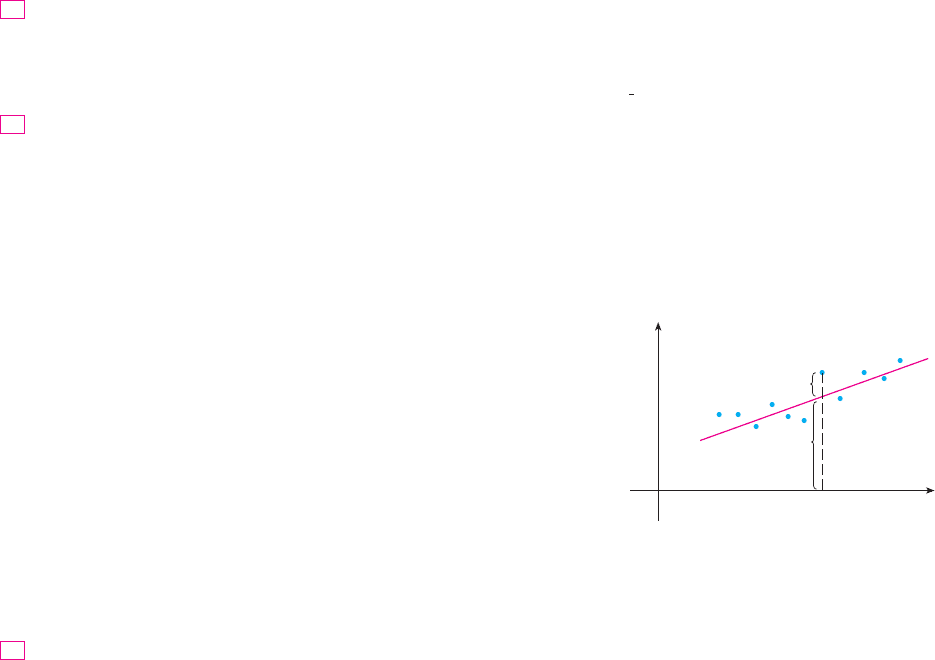
968
||||
CHAPTER 15 PARTIAL DERIVATIVES
(b) Find the dimensions that minimize heat loss. (Check both
the critical points and the points on the boundary of the
domain.)
(c) Could you design a building with even less heat loss
if the restrictions on the lengths of the walls were removed?
53. If the length of the diagonal of a rectangular box must be ,
what is the largest possible volume?
54. Three alleles (alternative versions of a gene) A, B, and O
determine the four blood types A (AA or AO), B (BB or BO),
O (OO), and AB. The Hardy-Weinberg Law states that the pro-
portion of individuals in a population who carry two different
alleles is
where , , and are the proportions of A, B, and O in the
population. Use the fact that to show that is
at most .
55. Suppose that a scientist has reason to believe that two quan-
tities and are related linearly, that is, , at least
approximately, for some values of and . The scientist
performs an experiment and collects data in the form of points
, , , and then plots these points. The
points don’t lie exactly on a straight line, so the scientist wants
to find constants and so that the line “fits” the
points as well as possible. (See the figure.)
Let be the vertical deviation of the point
from the line. The method of least squares determines
and so as to minimize , the sum of the squares of
these deviations. Show that, according to this method, the line
of best fit is obtained when
Thus the line is found by solving these two equations in the
two unknowns and . (See Section 1.2 for a further discus-
sion and applications of the method of least squares.)
56. Find an equation of the plane that passes through the point
and cuts off the smallest volume in the first octant.共1, 2, 3兲
bm
m
兺
n
i苷1
x
i
2
⫹ b
兺
n
i苷1
x
i
苷
兺
n
i苷1
x
i
y
i
m
兺
n
i苷1
x
i
⫹ bn 苷
兺
n
i苷1
y
i
冘
n
i苷1
d
i
2
bm
共x
i
, y
i
兲
d
i
苷 y
i
⫺ 共mx
i
⫹ b兲
(⁄,›)
(x
i
,y
i
)
mx
i
+b
d
i
y
x
0
y 苷 mx ⫹ bbm
..., 共x
n
, y
n
兲共x
2
, y
2
兲共x
1
, y
1
兲
bm
y 苷 mx ⫹ byx
2
3
Pp ⫹ q ⫹ r 苷 1
rqp
P 苷 2pq ⫹ 2pr ⫹ 2rq
L
an absolute maximum. But this is not true for functions of two
variables. Show that the function
has exactly one critical point, and that has a local maximum
there that is not an absolute maximum. Then use a computer to
produce a graph with a carefully chosen domain and viewpoint
to see how this is possible.
39. Find the shortest distance from the point to the
plane .
40. Find the point on the plane that is closest to the
point .
Find the points on the cone that are closest to the
point .
42. Find the points on the surface that are closest to
the origin.
Find three positive numbers whose sum is 100 and whose
product is a maximum.
44. Find three positive numbers whose sum is 12 and the sum of
whose squares is as small as possible.
45. Find the maximum volume of a rectangular box that is
inscribed in a sphere of radius .
46. Find the dimensions of the box with volume that has
minimal surface area.
47. Find the volume of the largest rectangular box in the first
octant with three faces in the coordinate planes and one
vertex in the plane .
48. Find the dimensions of the rectangular box with largest
volume if the total surface area is given as 64 cm .
49. Find the dimensions of a rectangular box of maximum volume
such that the sum of the lengths of its 12 edges is a constant .
50. The base of an aquarium with given volume is made of slate
and the sides are made of glass. If slate costs five times as
much (per unit area) as glass, find the dimensions of the aquar-
ium that minimize the cost of the materials.
A cardboard box without a lid is to have a volume of
32,000 cm Find the dimensions that minimize the amount
of cardboard used.
52. A rectangular building is being designed to minimize
heat loss. The east and west walls lose heat at a rate of
per day, the north and south walls at a rate of
per day, the floor at a rate of per day, and
the roof at a rate of per day. Each wall must be at
least 30 m long, the height must be at least 4 m, and the
volume must be exactly .
(a) Find and sketch the domain of the heat loss as a function of
the lengths of the sides.
4000 m
3
5 units兾m
2
1 unit兾m
2
8 units兾m
2
10 units兾m
2
3
.
51.
V
c
2
x ⫹ 2y ⫹ 3z 苷 6
1000 cm
3
r
43.
y
2
苷 9 ⫹ xz
共4, 2, 0兲
z
2
苷 x
2
⫹ y
2
41.
共1, 2, 3兲
x ⫺ y ⫹ z 苷 4
x ⫹ y ⫺ z 苷 1
共2, 1, ⫺1兲
f
f 共x, y兲 苷 3xe
y
⫺ x
3
⫺ e
3y
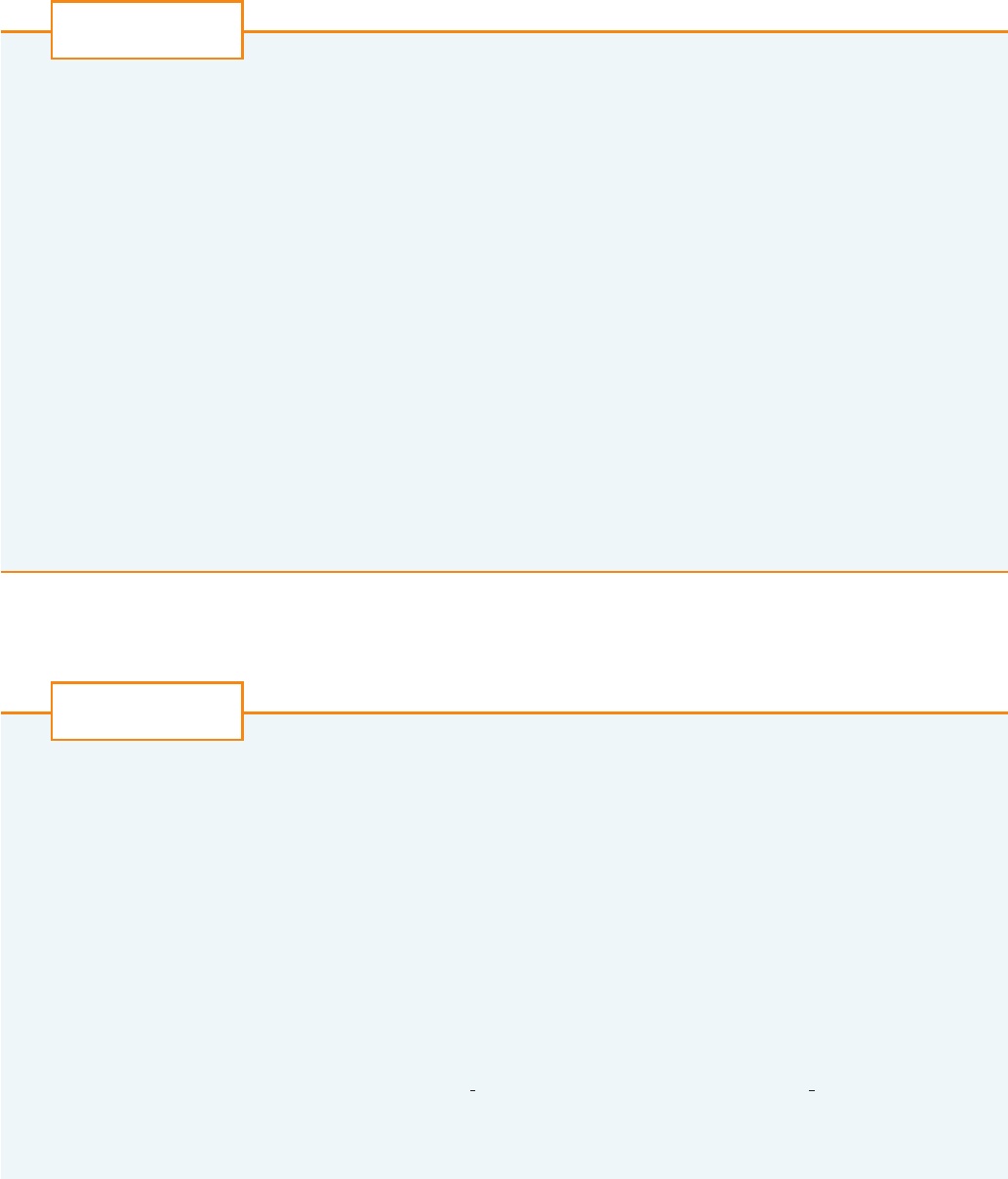
For this project we locate a trash dumpster in order to study its shape and construction. We
then attempt to determine the dimensions of a container of similar design that minimize
construction cost.
1. First locate a trash dumpster in your area. Carefully study and describe all details of its con-
struction, and determine its volume. Include a sketch of the container.
2. While maintaining the general shape and method of construction, determine the dimensions
such a container of the same volume should have in order to minimize the cost of construc-
tion. Use the following assumptions in your analysis:
N
The sides, back, and front are to be made from 12-gauge (0.1046 inch thick) steel sheets,
which cost $0.70 per square foot (including any required cuts or bends).
N
The base is to be made from a 10-gauge (0.1345 inch thick) steel sheet, which costs $0.90
per square foot.
N
Lids cost approximately $50.00 each, regardless of dimensions.
N
Welding costs approximately $0.18 per foot for material and labor combined.
Give justification of any further assumptions or simplifications made of the details of
construction.
3. Describe how any of your assumptions or simplifications may affect the final result.
4. If you were hired as a consultant on this investigation, what would your conclusions be?
Would you recommend altering the design of the dumpster? If so, describe the savings that
would result.
DESIGNING A DUMPSTER
APPLIED
PROJECT
DISCOVERY PROJECT QUADRATIC APPROXIMATIONS AND CRITICAL POINTS
||||
969
The Taylor polynomial approximation to functions of one variable that we discussed in Chap-
ter 12 can be extended to functions of two or more variables. Here we investigate quadratic
approximations to functions of two variables and use them to give insight into the Second
Derivatives Test for classifying critical points.
In Section 15.4 we discussed the linearization of a function of two variables at a
point :
Recall that the graph of is the tangent plane to the surface at and the
corresponding linear approximation is . The linearization is also called the
first-degree Taylor polynomial of at .
1. If has continuous second-order partial derivatives at , then the second-degree Taylor
polynomial of at is
and the approximation is called the quadratic approximation to at .
Verify that has the same first- and second-order partial derivatives as at
共a, b兲.fQ
共a, b兲ff 共x, y兲⬇Q共x, y兲
⫹
1
2
f
xx
共a, b兲共x ⫺ a兲
2
⫹ f
xy
共a, b兲共x ⫺ a兲共y ⫺ b兲 ⫹
1
2
f
yy
共a, b兲共y ⫺ b兲
2
Q共x, y兲 苷 f 共a, b兲 ⫹ f
x
共a, b兲共x ⫺ a兲 ⫹ f
y
共a, b兲共y ⫺ b兲
共a, b兲f
共a, b兲f
共a, b兲f
Lf 共x, y兲⬇L共x, y兲
共a, b, f 共a, b兲兲z 苷 f 共x, y兲L
L共x, y兲 苷 f 共a, b兲 ⫹ f
x
共a, b兲共x ⫺ a兲 ⫹ f
y
共a, b兲共y ⫺ b兲
共a, b兲
f
QUADRATIC APPROXIMATIONS AND CRITICAL POINTS
DISCOVERY
PROJECT
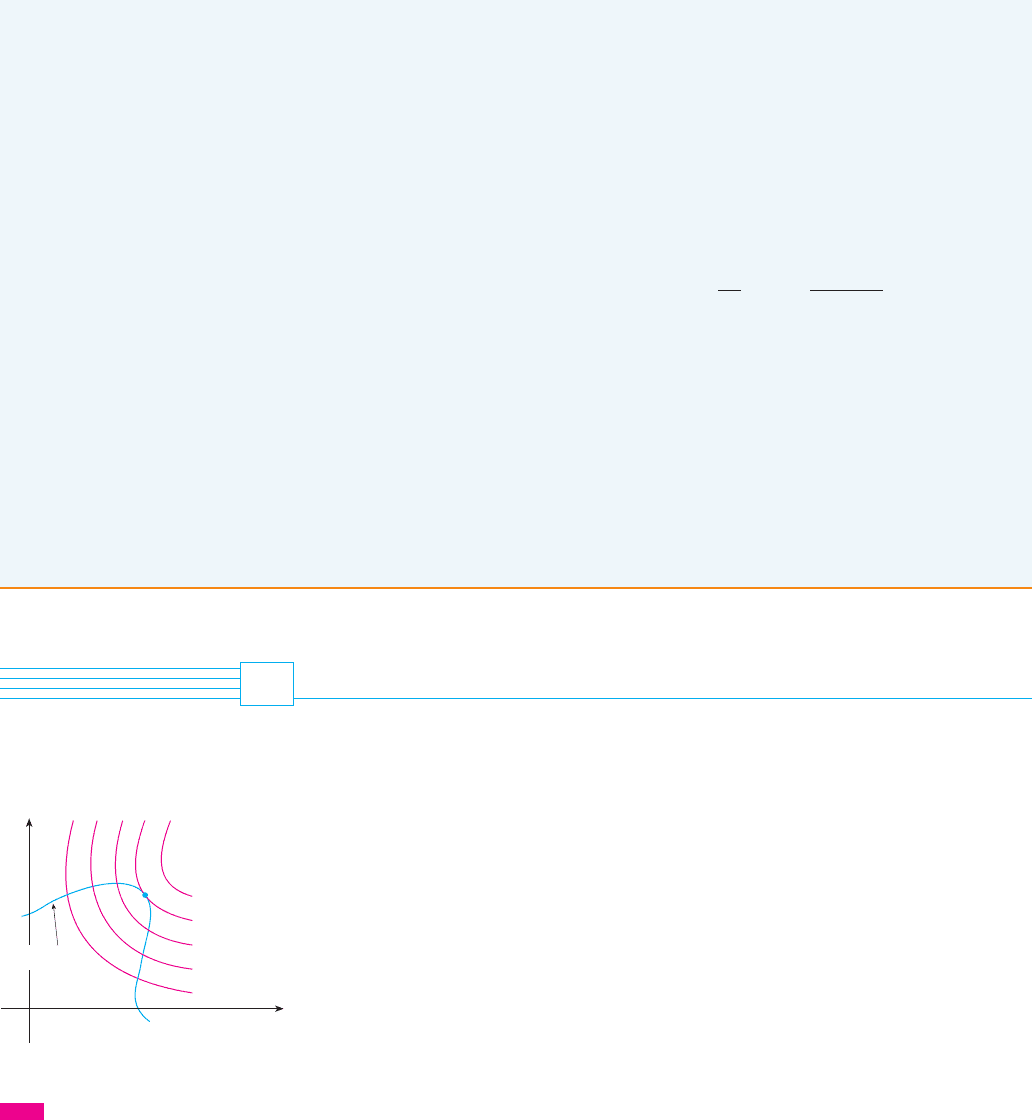
970
||||
CHAPTER 15 PARTIAL DERIVATIVES
2. (a) Find the first- and second-degree Taylor polynomials and of
at (0, 0).
;
(b) Graph , , and . Comment on how well and approximate .
3. (a) Find the first- and second-degree Taylor polynomials and for at (1, 0).
(b) Compare the values of , , and at (0.9, 0.1).
;
(c) Graph , , and . Comment on how well and approximate .
4. In this problem we analyze the behavior of the polynomial
(without using the Second Derivatives Test) by identifying the graph as a paraboloid.
(a) By completing the square, show that if , then
(b) Let . Show that if and , then has a local minimum
at (0, 0).
(c) Show that if and , then has a local maximum at (0, 0).
(d) Show that if , then (0, 0) is a saddle point.
5. (a) Suppose is any function with continuous second-order partial derivatives such that
and (0, 0) is a critical point of . Write an expression for the second-degree
Taylor polynomial, , of at (0, 0).
(b) What can you conclude about from Problem 4?
(c) In view of the quadratic approximation , what does part (b) suggest
about ?
f
f 共x, y兲⬇Q共x, y兲
Q
fQ
ff 共0, 0兲 苷 0
f
D
⬍
0
f
a
⬍
0
D ⬎ 0
fa ⬎ 0D ⬎ 0D 苷 4ac ⫺ b
2
f 共x, y兲 苷 ax
2
⫹ bxy ⫹ cy
2
苷 a
冋冉
x ⫹
b
2a
y
冊
2
⫹
冉
4ac ⫺ b
2
4a
2
冊
y
2
册
a 苷 0
f 共x, y兲 苷 ax
2
⫹ bxy ⫹ cy
2
fQLQLf
fQL
f 共x, y兲 苷 xe
y
QL
fQLQLf
f 共x, y兲 苷 e
⫺x
2
⫺y
2
QL
LAGRANGE MULTIPLIERS
In Example 6 in Section 15.7 we maximized a volume function subject to the
constraint , which expressed the side condition that the surface area
was 12 m . In this section we present Lagrange’s method for maximizing or minimizing
a general function subject to a constraint (or side condition) of the form
.
It’s easier to explain the geometric basis of Lagrange’s method for functions of two
variables. So we start by trying to find the extreme values of subject to a constraint
of the form . In other words, we seek the extreme values of when the
point is restricted to lie on the level curve . Figure 1 shows this curve
together with several level curves of . These have the equations where ,
, , , . To maximize subject to is to find the largest value of such
that the level curve intersects . It appears from Figure 1 that this
happens when these curves just touch each other, that is, when they have a common tan-
gent line. (Otherwise, the value of c could be increased further.) This means that the nor-
mal lines at the point where they touch are identical. So the gradient vectors are
parallel; that is, for some scalar .
This kind of argument also applies to the problem of finding the extreme values of
subject to the constraint . Thus the point is restricted to lie
on the level surface with equation . Instead of the level curves in Figure 1,
we consider the level surfaces and argue that if the maximum value of
is , then the level surface is tangent to the level surface
and so the corresponding gradient vectors are parallel.t共x, y, z兲 苷 k
f 共x, y, z兲 苷 cf 共x
0
, y
0
, z
0
兲 苷 c
ff 共x, y, z兲 苷 c
t共x, y, z兲 苷 kS
共x, y, z兲t共x, y, z兲 苷 kf 共x, y, z兲
ⵜf 共x
0
, y
0
兲 苷
ⵜt共x
0
, y
0
兲
共x
0
, y
0
兲
t共x, y兲 苷 kf 共x, y兲 苷 c
ct共x, y兲 苷 kf 共x, y兲111098
c 苷 7f 共x, y兲 苷 c,f
t共x, y兲 苷 k共x, y兲
f 共x, y兲t共x, y兲 苷 k
f 共x, y兲
t共x, y, z兲 苷 k
f 共x, y, z兲
2
2xz ⫹ 2yz ⫹ xy 苷 12
V 苷 xyz
15.8
f(x,y)=11
f(x,y)=10
f(x,y)=9
f(x,y)=8
f(x,y)=7
x
y
0
g(x,y)=k
FIGURE 1
Visual 15.8 animates Figure 1 for
both level curves and level surfaces.
TEC

This intuitive argument can be made precise as follows. Suppose that a function has
an extreme value at a point on the surface and let be a curve with vector
equation that lies on and passes through . If is the parameter
value corresponding to the point , then . The composite function
represents the values that takes on the curve . Since has an
extreme value at , it follows that has an extreme value at , so . But
if is differentiable, we can use the Chain Rule to write
This shows that the gradient vector is orthogonal to the tangent vector
to every such curve . But we already know from Section 15.6 that the gradient vector
of , , is also orthogonal to for every such curve
.
(See Equation 15.6.18.)
This means that the gradient vectors and must be parallel.
Therefore, if , there is a number such that
The number in Equation 1 is called a Lagrange multiplier. The procedure based on
Equation 1 is as follows.
METHOD OF LAGRANGE MULTIPLIERS To find the maximum and minimum values
of subject to the constraint [assuming that these extreme
values exist and on the surface ]:
(a) Find all values of , , , and such that
and
(b) Evaluate at all the points that result from step (a). The largest of
these values is the maximum value of ; the smallest is the minimum value
of .
If we write the vector equation in terms of its components, then the equa-
tions in step (a) become
This is a system of four equations in the four unknowns , , , and , but it is not neces-
sary to find explicit values for .
For functions of two variables the method of Lagrange multipliers is similar to the
method just described. To find the extreme values of subject to the constraint
, we look for values of , , and such that
t共x, y兲 苷 kandⵜf 共x, y兲 苷
ⵜt共x, y兲
yxt共x, y兲 苷 k
f 共x, y兲
zyx
t共x, y, z兲 苷 kf
z
苷
t
z
f
y
苷
t
y
f
x
苷
t
x
ⵜf 苷
ⵜt
f
f
共x, y, z兲f
t共x, y, z兲 苷 k
ⵜf 共x, y, z兲 苷
ⵜt共x, y, z兲
zyx
t共x, y, z兲 苷 kⵜt 苷 0
t共x, y, z兲 苷 kf 共x, y, z兲
ⵜf 共x
0
, y
0
, z
0
兲 苷
ⵜt共x
0
, y
0
, z
0
兲
1
ⵜt共x
0
, y
0
, z
0
兲 苷 0
ⵜt共x
0
, y
0
, z
0
兲ⵜ f 共x
0
, y
0
, z
0
兲
r⬘共t
0
兲ⵜt共x
0
, y
0
, z
0
兲t
C
r⬘共t
0
兲ⵜf 共x
0
, y
0
, z
0
兲
苷 ⵜ f 共x
0
, y
0
, z
0
兲 ⴢ r⬘共t
0
兲
苷 f
x
共x
0
, y
0
, z
0
兲x⬘共t
0
兲 ⫹ f
y
共x
0
, y
0
, z
0
兲y⬘共t
0
兲 ⫹ f
z
共x
0
, y
0
, z
0
兲z⬘共t
0
兲
0 苷 h⬘共t
0
兲
f
h⬘共t
0
兲 苷 0t
0
h共x
0
, y
0
, z
0
兲
fCfh共t兲 苷 f 共x共t兲, y共t兲, z共t兲兲
r共t
0
兲 苷 具x
0
, y
0
, z
0
典P
t
0
PSr共t兲 苷 具x共t兲, y共t兲, z共t兲典
CSP共x
0
, y
0
, z
0
兲
f
SECTION 15.8 LAGRANGE MULTIPLIERS
||||
971
N Lagrange multipliers are named after the
French-Italian mathematician Joseph-Louis
Lagrange (1736–1813). See page 217 for a
biographical sketch of Lagrange.
N In deriving Lagrange’s method we assumed
that . In each of our examples you can
check that at all points where
. See Exercise 21 for what can
go wrong if .ⵜt 苷 0
t共x, y, z兲 苷 k
ⵜt 苷 0
ⵜt 苷 0
